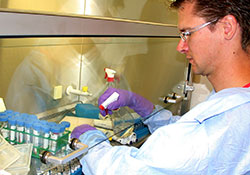How do you test for pandemic (H1N1) 2009?

Rob van Binnendijk
As the process of diagnostic testing is similar in every laboratory, this is a summary of the experts’ explanation.
A swab is taken from the nose or throat of someone with suspected pandemic (H1N1) 2009 virus infection. It is then sent to the laboratory; often the swab is split so that it can be tested in parallel or further analysed at another laboratory.
When the sample arrives, it is unpacked under appropriate biosafety conditions, which protect workers from infection, the sample from contamination and the environment. This requires that the lab worker wear protective clothing and the specimen be unpacked in an open safety cabinet where the air flow is controlled. Confirmation of pandemic (H1N1) 2009 in clinical specimens is currently performed using so-called polymerase chain reaction (PCR), the first step being to add a reagent to a portion of the specimen to deactivate the virus.
The PCR analysis (1) takes up to 8 hours, after which the sample is either identified or dismissed as pandemic (H1N1) 2009 virus infection. If necessary, the sample is then sent to a partner laboratory or a WHO collaborating centre for confirmation and additional analyses, which are essential to determine vaccine strain and antiviral susceptibility and to monitor for any changes in virulence.
National and international authorities (including WHO), and the hospital or physician and patient, are then informed of the results.
Test kits and assays (testing procedures) have been developed by the Centers for Disease Control and Prevention (CDC) in the United States of America and distributed by WHO. Some countries, such as the Netherlands and the United Kingdom, have developed their own assays and kits.
In addition to the diagnostic testing of individual cases, laboratories also analyse samples to study the make-up of the virus and spot variations from the virus first identified in April 2009.
1) PCR is a method for detecting small amounts of genetic material in e.g. a clinical specimen: to detect influenza viruses, a specific fragment of the virus’ genetic material (RNA) is amplified and the presence of this amplicon is considered a positive result. The reaction is specific, and extremely sensitive. PCR can be used for disease diagnosis, especially the detection of difficult-to-isolate pathogens, and analysing evolutionary relationships.



